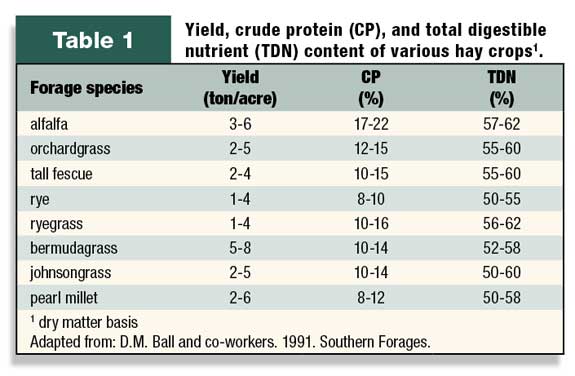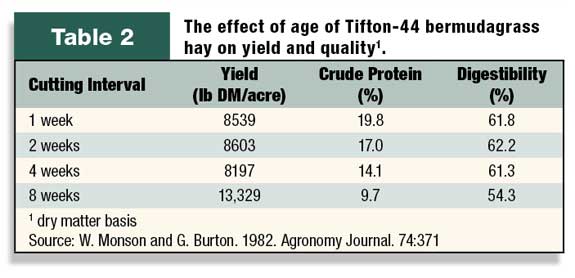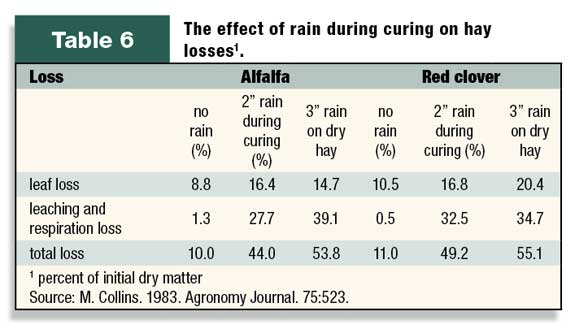When pasture growth is limited, some type of stored feed must be provided to grazing animals. Hay is one of the most versatile stored feeds available because:
- Accumulated forage from periods of excess growth can be cut for hay, which minimizes waste.
- It can be stored for long periods of time with little loss in nutritional value if protected from weather.
- It can be produced and fed in large or small amounts.
- It can be produced and fed either mechanically or manually.
- It can supply the nutrient requirements of most classes of livestock.
- A large number of crops can be used to produce hay.
Since hay is such a widely used stored feed, it is important to understand the factors that influence hay quality and the criteria used to evaluate hay quality.
This information can then be used to develop a feeding program that will be the most effective and efficient in meeting each producer’s goals.

Importance of hay quality
Hay quality is usually measured by the amount and availability of nutrients contained in the hay. The estimation of protein, fiber and digestibility of a hay can all be used to determine quality.
The ultimate test of hay quality, however, is animal performance. Quality can be considered satisfactory when animals consuming the hay perform as desired. Three factors which influence animal performance are:
- Intake – Hay must be palatable if it is to be consumed in adequate quantities to produce the desired performance.
- Digestibility and nutrient content – Once the hay is eaten, it must be digested and converted to animal products.
- Toxic factors – Hay must be free of components harmful to animals.
Factors affecting hay quality
There are many factors that will influence hay quality, some of which can be manipulated by the producer. These are:
- Plant species
- Stage of maturity
- Curing and handling conditions
- Soil fertility
- Seed quality
Plant species – The species of forage will have a large impact on hay quality. Legumes are generally higher quality than grasses, and cool-season grasses such as tall fescue and orchardgrass are higher quality than warm-season grasses like bermudagrass (Table 1).

Within each class there can be a wide range of quality, however. When properly cut, a mixture of a grass and legume usually produces high-quality hay.
Perennials such as alfalfa, orchardgrass, timothy, fescue, bermudagrass, etc. are usually more economical as hay crops than annuals, although annuals such as sorghum-sudangrass hybrids, pearl millet, small grains and ryegrass can be used effectively.
Stage of maturity when harvested – As grasses and legumes advance from the vegetative to the reproductive (seed) stage, they become higher in fiber and lower in protein, digestibility and palatability.
Forage quality deteriorates rapidly as the forage matures, even though yield continues to increase (Table 2).
Within each forage species, the most important factor that affects hay quality and the one where the greatest improvements can be made is stage of maturity.

The optimum stage of maturity for harvest of many hay crops is listed in Table 3.
As plant maturity advances, increased fiber levels and decreased crude protein and digestibility result in a drop in dry matter intake and milk production by cows consuming the hay (Tables 4 and 5).
The nutrient needs of gestating cows can be met by feeding hay. As more mature hay is used, however, the reduced nutrient content and digestibility of the hay results in the need for an increased level of grain supplementation for cows to maintain their body condition and rebreed after calving.
Curing and handling conditions – After mowing, poor weather and handling conditions can lower hay quality.
Rain can cause leaf loss and nutrient leaching from plants during curing (Table 6). Sunlight can reduce Vitamin A content through bleaching. Raking dry, brittle hay can cause excessive leaf loss.

Crushing stems (conditioning) at the time of mowing will cause stems to dry at nearly the same rate as leaves.
Conditioning has been shown to decrease the drying time of large-stemmed plants approximately one day and result in less leaf and nutrient loss.
Plants with an 80 percent moisture content must lose approximately 6,000 pounds of water to produce a ton of hay at 20 percent moisture.
Raking while hay is moist (40 percent moisture) and baling before hay is crisp (at 18 percent moisture) will help reduce leaf losses.
Soil fertility – Adequate amounts of lime, nitrogen, phosphate, potash and certain minor elements are needed to produce high yields of hay.

Maintaining a high level of fertility will also help to maintain the stand of desirable plants and prevent weed encroachment.
A soil test should be used as a guide in determining the amount of fertilizer and lime needed for economical hay production.
High yields of hay remove large amounts of nutrients. Since properly inoculated legume plants are capable of fixing atmospheric nitrogen, mixtures containing more than 30 percent legumes usually do not give economic responses to nitrogen fertilization. With pure grass stands, nitrogen must be added for high levels of production.
Seed quality – Plant certified seed of a recommended variety. This will ensure the use of quality seed of a variety adapted to local conditions.
Fall seedings should be made early enough for establishment before cold weather stops or slows growth. Late winter and early spring seedings should be made early enough to provide a vigorous stand which can survive summer drought and weed competition.
Clean seed (seed free of weed contamination) is important, especially when planting perennial hay crops. Weeds generally reduce hay quality by adding material lower in palatability and digestibility, while some may be harmful or toxic. Certified seed ensures quality.
Evaluating hay quality
Chemical evaluation – The most reliable way to determine hay quality is through chemical analysis. The Soil, Plant and Pest Center in Nashville, part of University of Tennessee Extension, can analyze a sample of hay for crude protein, fiber and total digestible nutrients.
These results can be used to assess quality and to determine type and amount of supplementation needed for the desired level of animal production.
Accuracy depends on obtaining a representative sample, which usually requires the use of a core sampler.
Determining hay quality and matching the quality to different classes of livestock based on nutrient requirements can lead to a more efficient forage-livestock program.

Contact your local Extension office for more information concerning forage testing.
Visual evaluation – Although not as reliable as forage testing, a visual estimate can be helpful in determining forage quality.
Learning what to look for in high-quality hay will help in determining when to cut hay and will give a guide for the relative ranking of hays. High-quality hay is early cut, green, soft, leafy, free of foreign material and has a pleasant odor.
Producing high-quality hay should be a goal of each cattle producer. Feeding high-quality hay during periods of reduced pasture growth can result in better weight gain in calves, and better milk production and rebreeding in cows.
Feeding high-quality hay can also reduce the level of grain supplementation needed during winter. Cutting hay early, proper fertilization and cutting when the hay will not get wet will allow cattle producers to get higher-quality hay and more efficient use of pastures.
—Excerpts from University of Tennessee forage newsletter











